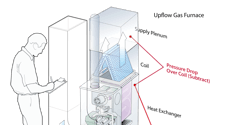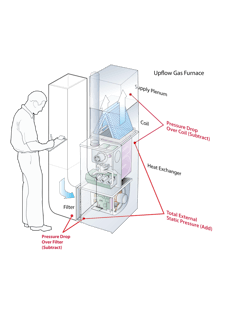Two Tests That Make Ordinary Service Calls Extraordinary
The summer heat is upon us, and the daily grind of non-stop calls will soon wear on you. It's easy to forget the value you provide during the madness. As a result, it's easy to start feeling numb each day as you move from one call to the next. The intense pace and heat suck the fun out of what you do.
What if there was a way to add something a little extra to each service call and make the job more interesting and fun? I'm not talking about doing more work but cutting out the unessential things you do and replacing them with something better. Let's look at two tests you can add to any ordinary service call and make it extraordinary for you and your customers.
Static Pressure
As an industry, we have a bad habit of assuming the duct systems we see each day work properly. We get so focused on the equipment that we forget to look at what's attached to it. What if you could get a glimpse into how well the HVAC system's airside performs? If you measure static pressure on each service call, you can.
Total External Static Pressure (TESP) is the first pressure to measure. It's the amount of resistance the air handling equipment must overcome to move air through the duct system and over components like air filters and coils. You can think of TESP as the HVAC system's blood pressure and an overall health indicator.
Filter pressure drop helps you see how restrictive the air filter is. This test can lead you to provide the customer with filter upgrades. Two pressure measurements will determine if the filter is too small or restrictive. Replacing a restrictive filter and retesting can prove the impact of a clean filter compared to the old one.
Coil pressure drop is a quick way to determine if an indoor coil is restrictive. Instead of tearing into the coil cabinet, this measurement helps you decide when to visually inspect the coil to see if it's plugged up with dirt and debris. If you need to clean the coil, you can compare the before and after pressure drop measurements to verify a successful cleaning.
Coil pressure drop is a quick way to determine if an indoor coil is restrictive. Duct pressures give you a glimpse into how restrictive the supply and return duct systems are.
Duct pressures give you a glimpse into how restrictive the supply and return duct systems are. A single pressure reading where air enters the air handling equipment reveals the condition of the return duct system. A second pressure reading where air exits the air handling equipment shows the condition of the supply duct system. If pressures are high, you can move down the duct system in four-foot increments until you discover a significant change in pressure. Use this test to diagnose poor fittings and internal duct restrictions.
System Temperatures
Most service technicians measure supply and return dry bulb (db) temperatures from the equipment. However, if you add the farthest supply register and return grille temperatures to your calls, you look beyond the equipment and see the duct system's influence.
When you take supply register and return grille temperatures, you can see how much cooling is lost through duct system insulation and leakage. Many technicians use the equipment temperature drop (Δt) as a performance indicator. But you can also look at the duct system Δt and compare it to the equipment's Δt. A duct system without excessive temperature loss should have a temperature change within 10% of the equipment's Δt.
Measuring these two extra temperature readings opens the door for many opportunities to correct issues that have gone uncovered for decades. You may help a customer decide to stick with your company because you gave them the extra information that helped them discover why one room in their home is always uncomfortable.
Add Something ExtraWith the two measurements we briefly covered, you can help customers see a side of their HVAC system they've never seen before. These tests make work fun again because you never know what you'll find. One reading may hold the clue to a problem your customer would pay dearly to solve.
It doesn't take much additional testing or time to achieve these results. With the right tools and some practice, you can typically add "something extra" to your service calls in less than five minutes.
If you attach your manifold gauges to every cooling system you service, that's one non-essential thing you can stop. Only gauge up when needed.
The trick is figuring out the unessential things you do on each service call and replacing them with measurements that matter. For example, if you attach your manifold gauges to every cooling system you service, that's one non-essential thing you can stop. Only gauge up when needed.
As you move to each call, ask yourself, are you checking boxes and punching the clock, or did you make a difference? Consider how you can use these two tests to move past the summer insanity and make a difference in your customers' lives. Add something "extra" to your ordinary calls and make them extraordinary.
David Richardson serves the HVAC industry as Director of Training for the National Comfort Institute, Inc. (NCI). NCI specializes in training to improve, measure, and verify HVAC and Building Performance.
If you're an HVAC contractor or technician interested in learning about how to make your service calls extraordinary, contact David at ncilink.com/ContactMe. NCI's website www.nationalcomfortinstitute.com is full of free information to help you improve your professionalism and strengthen your company.
About the Author
David Richardson
Director, technical curriculum
David Richardson serves the HVAC industry as director of technical curriculum at National Comfort Institute, Inc. (NCI), Avon, Ohio. NCI specializes in training that focuses on improving, measuring, and verifying HVAC and Building Performance.

